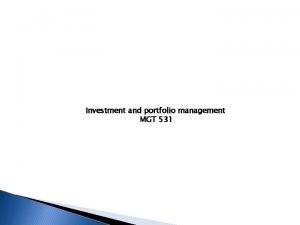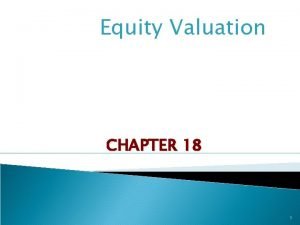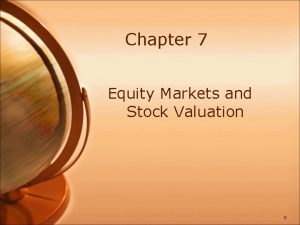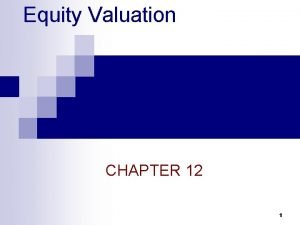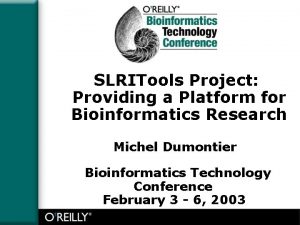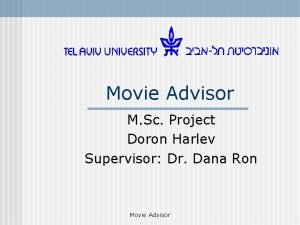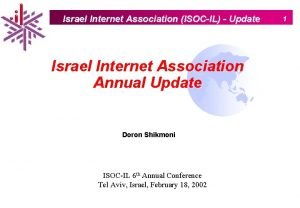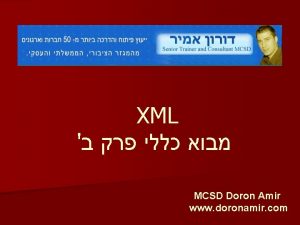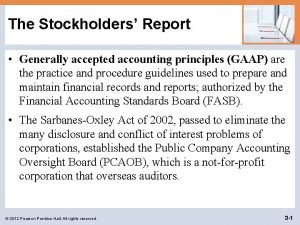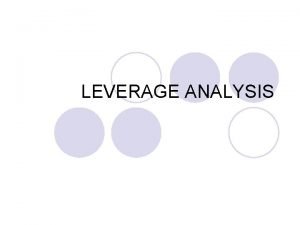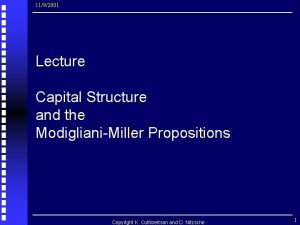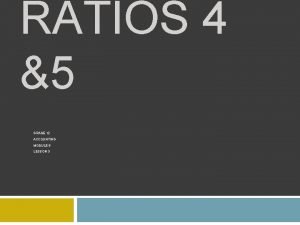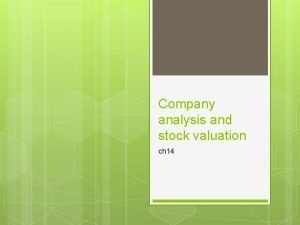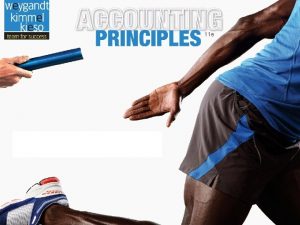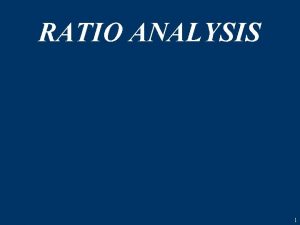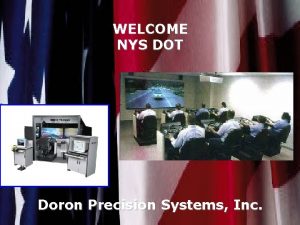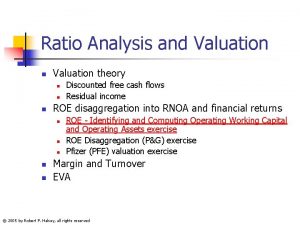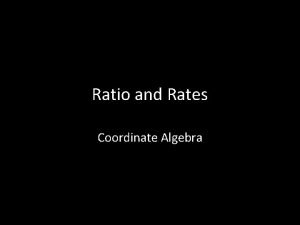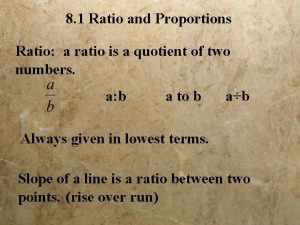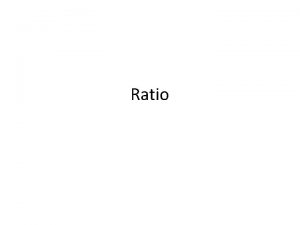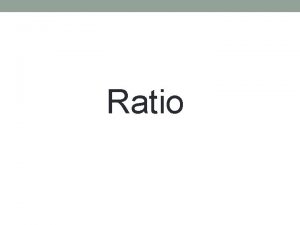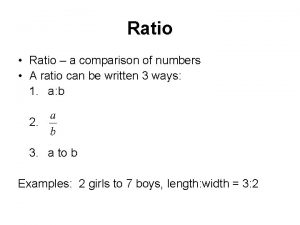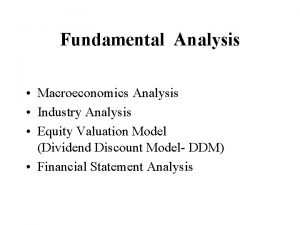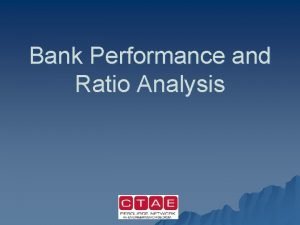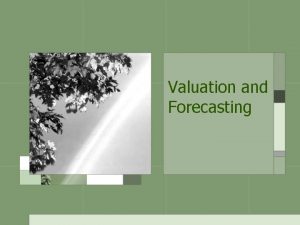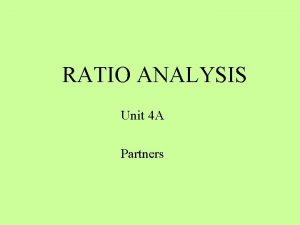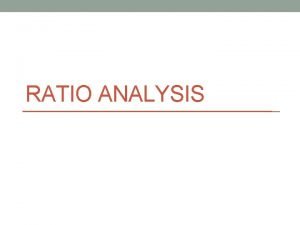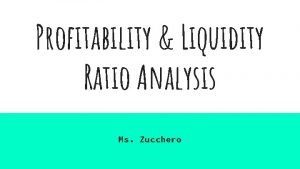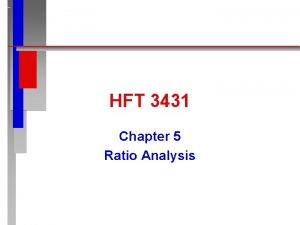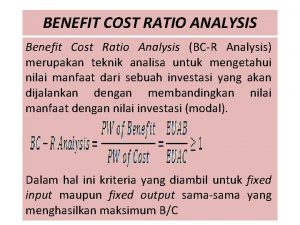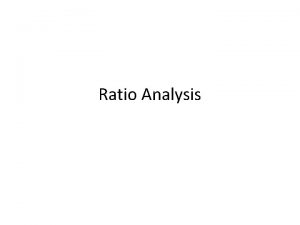Ratio Analysis and Equity Valuation Doron Nissim Stephen
























- Slides: 24

Ratio Analysis and Equity Valuation Doron Nissim Stephen H. Penman

Abstract & Objective Value Model-Identify CONTENTS Value Model-Document Summary & Reflection

Abstract and Research Objective PART 1

Abstract and Research Objective Abstract This paper outlines a financial statement analysis for use in equity valuation. Standard profitability analysis is incorporated, and extended, and is complemented with an analysis of growth. The perspective is one of forecasting payoffs to equities. 1. 2. General Value Analysis and Forecast: Financial statement analysis pro forma analysis of the future (forecasted ratios viewed as building blocks of forecasts of payoffs). Detailed Components Analysis Focused on Equity: Current financial statements current ratios future ratios driving equity payoffs. (financial statement analysis is hierarchical, with ratios lower in the ordering contain finer information). To provide historical benchmarks forecasting, typical values for ratios are documented for the period 1963 -1996, along with their cross-sectional variation and correlation. And, again with a view to forecasting, the time series behavior of many of the ratios is also described and their typical “long-run, steady-state” levels are documented.

Abstract and Research Objective Identify Analysis Method Model and Value Selection • • Valuation Model and Financial Statement have same accrualbasis. Comprehensive Income coincides with FASB • • Operating and financingactivities separation–M&M Proposition. Asset value traits – fair value. Application and Extension • • More hierarchical and fine, combine profitability with growth. Value drivers are classified into “transitory” and “permanent”.

Abstract and Research Objective Documentation • • Resolve ratios that are defined differently from standard texts. Find interaction between value drivers forecasting and valuation. Cross-sectional analysis • • Time series analysis Model requirement – Continuing Value requires ‘steady state’ Find general model – identify ‘transitory’ and ‘permanent’.

Residual Valuation Model Identification PART 2

Residual Income Valuation Model Impractical for infinite-horizon forecasting, so model is modified with original part works for finite-horizon and Continuing Value is added at the forecast horizon T. Model Ratio Drivers RE & ROCE Primary value drivers with detailed drivers

The Drivers of ROCE Decomposition ROCE is a weighted average of the return on operating activities and the return on financing activities. Income statement amounts are for the period and balance sheet amounts for the beginning of the period Thus ROCE is driven by the return on operations with an additional return from the leverage of financial activities. This leverage effect is determined by the amount of leverage and the spread between the return on operations and net borrowing costs. This decomposition of RNOA into PM and ATO follows the standard Du. Pont analysis.

The Drivers of ROCE Decomposition PM captures profitability of each dollar of sales, and it also captures items not recorded in sales, such as equity share of income in a subsidiary, dividends, and gains and losses on equity investments marked to market. So we decompose further,

The Drivers of ROCE Decomposition Put Minority Interest into consideration

The Drivers of ROCE Decomposition Put Operating Liability into consideration RNOA is levered up by operating liability leverage and the leverage effect is determined by the operating liability leverage and the spread between ROA and the implicit borrowing cost

ROCE Value Drivers

The Driver of CSE When it comes to Book Value, the other part of valuation model, the breakdown shows that the Minority Interest is not within the equation. The last term of the equation captures the financial decision. Now the value drivers identification is finished, the authors have identified totally 10 value drivers corresponding to ROCE and CSE. In order to make the analysis more consciously, the paper continues to reduce the analysis by splitting operating and financing.

Reduce the analysis If financial obligation and assets are measured at market value, then the incremental part of NFO will be zer 0, this reduces Re. NFE to 0. Now we convert RE into Re. OI, and we do not need to find value drivers of ROCE and RE, instead we redirect the identification to RNOA and NOA.

Reduce the analysis Now there are only 6 value drivers, which corresponds to RNOA and NOA. Up till now, the analysis is focused on finite part, then the authors focus on infinite part – CV and its growth rate.

The Drivers of CV and Growth Constant RONA ------ NOA Constant RNOA, constant PM, constant ATO ------- NOA (Sales) Varying RNOA and constant NOA -------- RNOA

Financial Statement Analysis – Forecasting The model is expected to give the right valuation and also the forecasting, so the authors classify “permanent” items as “Core Items” and these ratios/accounts will not decay.

Documentation PART 3

Documentation – Cross Sectional RNOA is higher at the mean and median the traditional ROTA, so typically operating liability leverage is used favorably, contributing to the difference between RNOA and ROTA. FLEV~SPREAD: Historical data shows that both spread and RNOA are negatively related to FLEV, contradicting to the predicted relationship. OLLEV~OLSPREAD: positive relationship indicates that the OLSPREAD could lever RNOA up. Verify theory Interaction Time series analysis Interaction FLEV capture operations such as buying financial assets and operating liability. However, Debt/Equity does not reflect these two. RNOA~Growth in NOA: One might expect firms that generate higher RNOA to grow their net operating assets. But growth in NOA reduces RNOA if the accounting is conservative. The value driver of RNOA is positively related with RNOA, but is slightly.

Documentation – Time Series Construct 10 portfolios, restructure them every 5 years by average of median return. Companies below certain thresholds will be dropped out. Corr – correlation of the new portfolios with the old ones; high Corr indicates that the ratios persist. Var – qualify the speed of mean reversion, the higher the Var, the higher volatility of the drivers. RE has momentum and converges, but gradually decays. Forecasted RE , Re. OI is positive, but the real value is positive, indicating that the assumed equity risk premium is too high, but uncertain about conservative accounting.

Summary and Reflection PART 4

Summary and Reflection Improvement Uncertainty – assume business grows and continues smoothly, does count additional investment or unexpected expenses, reflected in discount rates. Summary Structure - hierarchical financial statement analysis that facilitates forecasting and valuation. Extension - Expand analysis from profitability to growth. Universality - Analysis structure works on Residual Earnings model and also FCF and Dividend Model.

 Doron nissim
Doron nissim Equity analysis and valuation
Equity analysis and valuation How to calculate intrinsic value
How to calculate intrinsic value Equity markets and stock valuation
Equity markets and stock valuation Fixed income introduction
Fixed income introduction Importance of equity
Importance of equity Equity valuation ppt
Equity valuation ppt Dividend discount model
Dividend discount model Doron betel
Doron betel Dr doron amir
Dr doron amir Isocil
Isocil Dr doron amir
Dr doron amir Prologn
Prologn Doron harlev
Doron harlev I remember the night my mother was stung by a scorpion
I remember the night my mother was stung by a scorpion The longest epic of the world
The longest epic of the world Nissim amzallag
Nissim amzallag Return on common stockholders' equity ratio formula
Return on common stockholders' equity ratio formula Net debt to equity ratio
Net debt to equity ratio Composite leverage
Composite leverage Return on common stockholders equity formula
Return on common stockholders equity formula Wacc formula with debt to equity ratio
Wacc formula with debt to equity ratio Wacc formula with debt to equity ratio
Wacc formula with debt to equity ratio Debt equity ratio formula grade 12
Debt equity ratio formula grade 12 Company analysis
Company analysis

